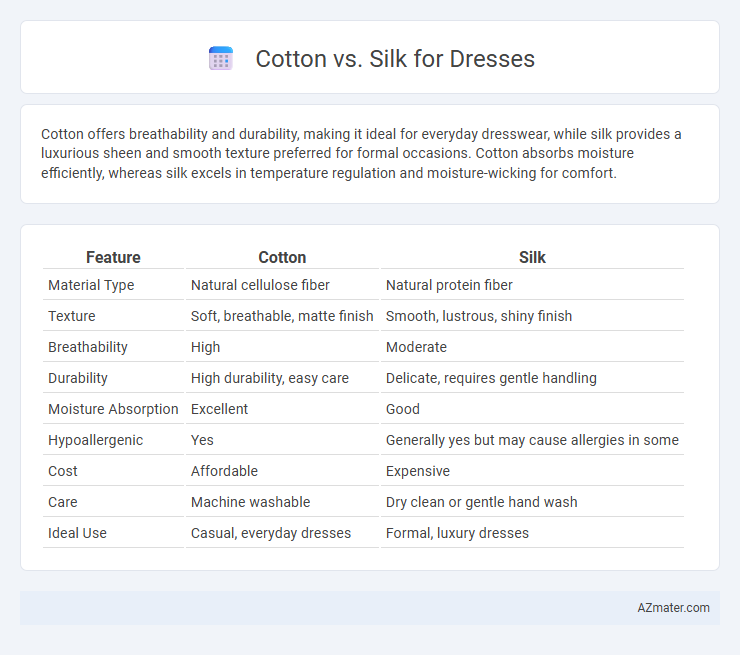Cotton offers breathability and durability, making it ideal for everyday dresswear, while silk provides a luxurious sheen and smooth texture preferred for formal occasions. Cotton absorbs moisture efficiently, whereas silk excels in temperature regulation and moisture-wicking for comfort.
Table of Comparison
| Feature | Cotton | Silk |
|---|---|---|
| Material Type | Natural cellulose fiber | Natural protein fiber |
| Texture | Soft, breathable, matte finish | Smooth, lustrous, shiny finish |
| Breathability | High | Moderate |
| Durability | High durability, easy care | Delicate, requires gentle handling |
| Moisture Absorption | Excellent | Good |
| Hypoallergenic | Yes | Generally yes but may cause allergies in some |
| Cost | Affordable | Expensive |
| Care | Machine washable | Dry clean or gentle hand wash |
| Ideal Use | Casual, everyday dresses | Formal, luxury dresses |
Introduction: Cotton vs Silk for Dresses
Cotton and silk are two popular fabrics for dresses, each offering distinct advantages. Cotton is breathable, durable, and easy to care for, making it ideal for everyday wear and warmer climates. Silk provides a luxurious feel, natural sheen, and excellent drape, perfect for formal occasions and elegant styles.
Fabric Origins and Production Process
Cotton fabric originates from the natural fibers of the cotton plant, harvested and spun into yarn through mechanical or manual processes, making it widely accessible and affordable. Silk, derived from the cocoons of the silkworm, undergoes a labor-intensive process called sericulture, where fibers are carefully unwound and woven, resulting in a luxurious texture. The distinct origins and production methods of cotton and silk directly impact their breathability, texture, and cost in dressmaking.
Texture and Feel: Comfort Comparison
Cotton offers a soft, breathable texture that absorbs moisture, providing a cool and comfortable feel ideal for warm weather. Silk has a smooth, luxurious texture with a natural sheen, offering a lightweight and gentle feel against the skin, suitable for formal occasions or cooler climates. Cotton's matte finish contrasts with silk's glossy surface, making each fabric distinct in comfort and visual appeal.
Breathability and Moisture Management
Cotton excels in breathability due to its natural fibers that allow air to circulate freely, making it ideal for warm weather and active wear. Silk offers moderate breathability but stands out for its superior moisture-wicking capabilities, efficiently drawing sweat away from the skin to keep the wearer dry and comfortable. While cotton absorbs moisture effectively, it tends to retain it longer than silk, which dries quickly, enhancing overall moisture management in silk garments.
Durability and Longevity Factors
Cotton dresses offer superior durability due to their strong natural fibers that withstand frequent washing and everyday wear, making them ideal for long-term use. Silk, while luxurious and soft, is more delicate and prone to damage from friction, sunlight, and moisture, which can shorten its lifespan without careful maintenance. Choosing cotton over silk enhances dress longevity by providing resistance to shrinking, tearing, and fading during extended use.
Style Versatility and Draping Qualities
Cotton offers casual style versatility with breathable, lightweight comfort, making it ideal for everyday wear and relaxed silhouettes. Silk provides exquisite draping qualities with a smooth, lustrous finish that elegantly enhances formal and evening dresses. The natural sheen and fluidity of silk create graceful movement, while cotton's structured texture supports more tailored, versatile designs.
Maintenance and Care Requirements
Cotton dresses require regular washing and are generally machine washable, making them easy to maintain with mild detergents and moderate drying settings to prevent shrinkage. Silk dresses demand more delicate care, often necessitating hand washing or dry cleaning to preserve fibers and prevent damage from harsh chemicals or high temperatures. Proper storage for silk includes avoiding direct sunlight and using padded hangers to maintain fabric integrity and prevent wrinkles.
Sustainability and Environmental Impact
Cotton dresses require significant water usage and pesticides, leading to substantial environmental strain, while organic cotton offers a more sustainable alternative with lower ecological footprints. Silk production involves natural fibers and biodegradability but often relies on intensive labor and energy consumption, impacting ecosystems and raising ethical concerns. Choosing sustainable sources like organic cotton or peace silk minimizes environmental impact, promoting eco-friendly fashion choices.
Price Comparison: Affordable or Luxury?
Cotton dresses are significantly more affordable, with prices typically ranging from $20 to $100, making them accessible for everyday wear and budget-conscious shoppers. Silk dresses, known for their luxurious texture and sheen, usually start around $100 and can exceed $1,000, reflecting their premium quality and exclusivity. The price difference stems from the raw material costs, production complexity, and maintenance requirements associated with silk compared to cotton.
Conclusion: Choosing the Right Fabric for Your Dress
Cotton offers breathability, comfort, and easy maintenance, making it ideal for everyday dresses and warm weather. Silk provides a luxurious feel, natural sheen, and elegance, perfect for formal occasions and evening wear. Selecting the right fabric depends on your dress's purpose, desired texture, and care preferences to ensure both comfort and style.

Infographic: Cotton vs Silk for Dress
 azmater.com
azmater.com